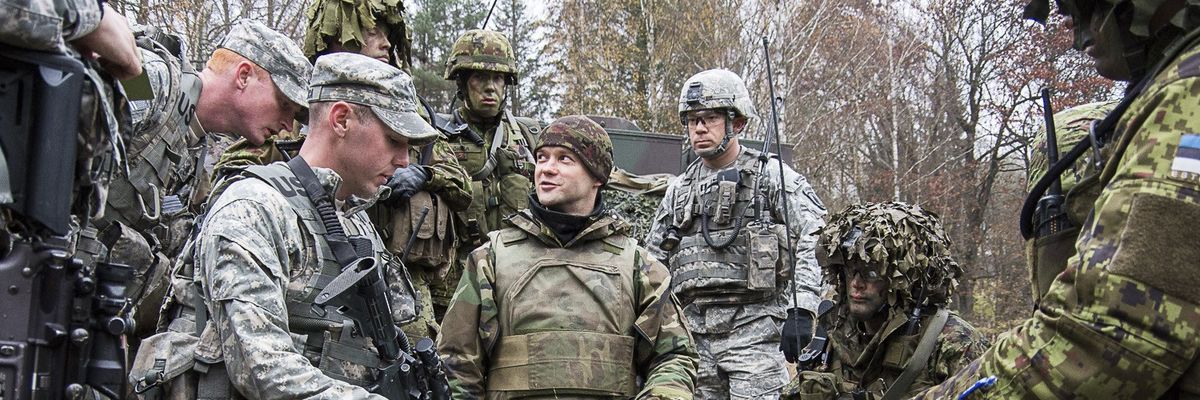Last week, the United States responded to Russia’s mid-December demarche which outlined its vision of what a revised post-Cold War European security architecture might look like.
Russia's objections to NATO's expansion to include Ukraine and Georgia are by now well known. Washington’s refusal to accommodate Russian concerns with regard to this issue is equally well known. But perhaps there’s more to Russian anxieties than just NATO expansion.
Less remarked upon have been Russia’s strategic anxieties relating to a series of large-scale military exercises Washington and its NATO partners have held in Eastern Europe over the past two years. In October 2019, for example, the U.S. Army announced that its ”Defender Europe,” or Defender 20, exercise was to be the largest test deployment of U.S. forces to Europe in a quarter century. The original iteration of the exercise, before COVID curtailed the plan, involved 20,000 U.S. service personnel who, according to Defense News, were to move from bases in North America “to locations across Europe, including Poland, the Baltics, some Nordic nations and Germany.”
The following year, as part of the “Steadfast Defender 2021” exercise, the Pentagon deployed 9,000 troops to Europe, including countries in the Balkans, and the Black Sea basin.
These exercises recall those held annually by NATO from 1967 to 1993. The Return of Forces to Germany, or REFORGER, exercises were held to reassure NATO allies that the U.S. military retained its ability to quickly deploy to Europe should the need arise for reinforcements in the event of an invasion by the Warsaw Pact. It was part of a series of Cold War-era exercises which included the now infamous Able Archer exercise. In 1983, Able Archer, which tested the command and control procedures for conventional and nuclear weapons, brought the Cold War to its most dangerous point since the 1963 Cuban Missile Crisis.
However, the dissolution of the Warsaw Pact in 1991 obviated the need for such exercises. The last REFORGER exercise was held in 1993.
Clearly, the announcement of the return of REFORGER-like exercises has caught the Kremlin’s attention: Articles 1, 2 and 7 of the Russian draft treaty’s nine articles specifically mention “military exercises.”
Article 1 sets out a requirement that NATO and the Russian Federation “exercise restraint in military planning and conducting exercises to reduce risks of eventual dangerous situations in accordance with their obligations under international law.”
Article 2 of the Russian draft treaty requests that the parties “inform each other about military exercises and maneuvers, and main provisions of their military doctrines,” while Article 7 stipulates that the parties “not conduct military exercises or other military activities above the brigade level in a zone of agreed width and configuration on each side of the border line” between Russia and NATO-allied countries. In short, the Russians likely see the reemergence of REFORGER-like exercises on their Western border as both provocative and destabilizing.
Yet the United States and NATO are hardly alone in holding such large-scale, military exercises in the region. In addition to regular troop build-ups in Belarus and around the borders of non-NATO countries like Ukraine, Russia has conducted large-scale military exercises near the territory of NATO members Estonia, Latvia, Lithuania, Poland, Romania and Bulgaria.
Indeed, over the past several years, Russia has held a series of military exercises in each of its military districts: Western (Zapad), Southern (Kavkaz), Central (Tsentr), and Eastern (Vostok).
Perhaps the most notable of these was the 2021 Zapad exercise which Russia and Belarus held with a combined 200,000 troops, far larger than any exercise held by the U.S. and NATO, and far in excess of previously agreed upon troop limits established by the Organization for Security and Cooperation Europe (OSCE).
And so, with the security concerns of NATO partners on or near Russia’s western borders no doubt in mind, the Biden administration, in its response to the Russian draft treaty, seemed to welcome talks over military exercises. Its response proposed a series of concrete steps, including strengthening the OSCE’s Vienna Document which set out a number of provisions aimed at facilitating the exchange of information among members regarding military activities in Europe.
In addition, the U.S. proposed to continue “the practice of exchanging briefings on Russian and NATO exercises in the NATO-Russia Council,” and to consult “on concrete ways to prevent incidents in the air and at sea with a view to rebuild trust and confidence and increase predictability in the Euro-Atlantic region.”
The U.S. position on military exercises was also addressed in a confidential non-paper sent to the Russian government and obtained by the Spanish newspaper El Pais. In it, Washington proposed that the two sides discuss the issue under the auspices of the OSCE, the NATO-Russia Council, and the U.S.-Russia Strategic Stability Dialogue. The non-paper also stated that the United States is prepared to “discuss measures to increase confidence regarding significant ground-based exercises in Europe,” as well as to explore “an enhanced notification regime and nuclear risk reduction measures.”
And so, while agreement on NATO expansion likely remains out of reach, Washington and Moscow should not let this current crisis go to waste. Instead, they should seize this opportunity to strengthen transparency and confidence-building measures to increase stability and predictability in what is now Europe’s most volatile region.















